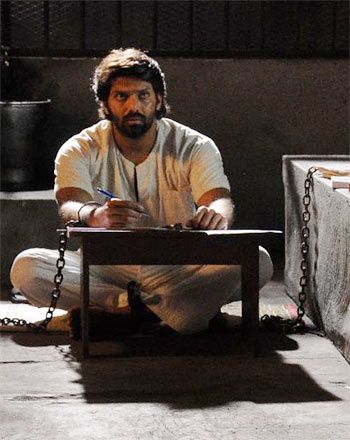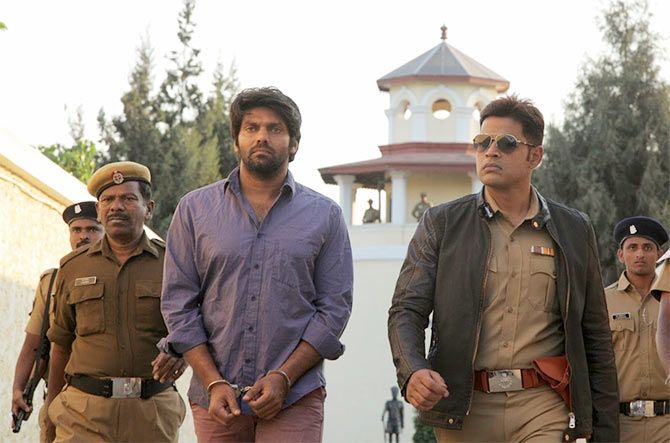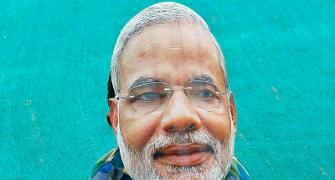 After a hiatus of six years, National award-winning director S P Jananathan is back with a brilliant political thriller titled Purampokku Engira Podhuvudamai which released last week.
After a hiatus of six years, National award-winning director S P Jananathan is back with a brilliant political thriller titled Purampokku Engira Podhuvudamai which released last week.
An offbeat film starring Arya, Shaam, Vijay Sethupathi and Karthika Nair, it gives a realistic portrayal of life in prison and reflects on the death penalty, it opened to rave reviews.
In this interview with S Saraswathi/Rediff.com, the director talks about what inspired the script, characters, and climax and shares his thoughts on the death penalty.
Your film seems to have garnered a lot of positive reviews. How does it feel?
Many people have called to congratulate me. They were deeply moved by the story.
It’s good to hear all this positive response for the film. Both the audience and the critics seem to have enjoyed it.
What inspired this script?
In the Rajiv Gandhi assassination case, all the 26 accused were awarded the death penalty. Later, following the emotional uproar and public appeal, the death penalty was commuted to life imprisonment.
There was a lot of debate and people openly opposed the sentencing.
But when serial killer Auto Shankar from Chennai, and Dhananjoy Chatterjee, the brutal rapist were executed, people did not protest.
They did not feel bad for these people. But in this case, people were against it.
The existence of the death penalty, its appropriateness and legality is a discussion that is happening worldwide.
At the core of this discussion is human life and its ultimate value. I wanted to make a film that brings out this value.
My entire film is centred on that. My heroine, Karthika, is a revolutionary who is willing to give up her life for a cause, but she does not want to be responsible for the death of another human being.
Arya, a passionate communist feels justified in giving up his life so his message reaches the people.
Shaam is a dedicated government servant, who believes that the law should be followed, even if it means taking someone's life.
While hangman Vijay Sethupathi is of the opinion that since he has no enmity with the said individual, he should not be forced to take another's life.
Being responsible for someone's life is a burden which not everyone can bear, as you will see in the climax of the film.
The climax was unexpected. Were you worried about how audiences would respond?
The film could have had two different endings. One was that Arya would die and the other, he would escape.
If he escaped, then the film would have turned into a prison break film. That was not my intention.
In many films, we have seen self-sacrificing characters or honest and dedicated police officials. But what Tamil cinema has not seen before is a hangman.
The character Yemalingam that Vijay Sethupathi played in the film was vital and I wanted his story to be complete. And if there was no hanging in the end, then it would all become meaningless.
I knew that I was taking a risk and that the film may not appeal to a family audience and would perhaps not be suitable for children. But I did not want to compromise on an important issue in the film for this reason.
I may not have the required audience, but the film will definitely have more impact, is what I believed.
But the mindset of the audience is such that they keep hoping till the very end that Arya will be able to somehow escape.
This could also be because it is Arya essaying the role; had it been somebody who regularly played negative characters they would not feel so bad.

So you are against the death penalty?
No, I am not advocating anything. There are circumstances when it cannot be avoided, we have to accept that.
Why did you bring communism into the film?
My film deals with the death penalty. There have been several instances in our country when the death penalty has been carried out.
As I mentioned earlier, it is only certain circumstances that evoke our empathy; we do not connect or sympathise with everyone who is awarded the death penalty.
So for people to be affected, I needed my hero to be pure. At the same time, he has to commit a crime that is serious enough to qualify for a death penalty.
He has to be a little extreme, but righteous as well. I felt I could aptly portray that with a revolutionary character supporting the communist ideology.
What is the relevance of the title of the film?
Actually the word ‘Purampokku’ is part of our traditional land management. The land, which is useful for the community as a whole was regarded as Purampokku, a very essential part of our land division.
For example, every village requires Purampokku land; we need some grazing land for the cattle, we need a water source, a graveyard, a bus stand, etc.
It is not an abusive term, but people today use it in a negative manner. To me, the term signified someone who is an important part of the community, a leader fighting for the good of everyone.
Were you particular about getting Arya, Shaam and Vijay Sethupathi?
My first priority was getting the budget for my film. The set alone cost Rs 1.5 crore.
To have someone investing such a huge amount would require that I get actors who have market value, who can take the message to the people.
So I needed established actors who already have a standing among the audience. This was not possible with newcomers.
But of course, there is always the question of what would be possible for whom. I needed some minute performances for my Yemalingam character and I felt that Vijay Sethupathi would be able to deliver, and it worked out great.
Arya has the image of a lover boy, so I wanted to create a contrast, show him as a revolutionary. Shaam, I have worked with before and knew he would suit the character.
And Karthika Nair?
I wanted someone who was tough. I also needed someone, who could speak the language well.
Most actresses in the Tamil industry don't know Tamil. Moreover, I wanted to be able to communicate with my actors in Tamil.
Actually, even that turned out to be tough, as we had many words which even she had not heard of before.

You seem to give a lot of importance to the backdrop of your films; you have depicted the ocean (in Iyarkai), the forest (Peranmai), slums (E) and now a prison.
I believe the word backdrop comes from the stage. On the stage, however, it is only two-dimensional. We can probably go left and right, or up and down, but we cannot go inside.
But that becomes possible in cinema. So, naturally, it should form an essential part of the story. It should not be like a painting chart, but rather as an important character in the film.
The spectacular ocean was my canvas in the film Iyarkai, which won the National Award. But even today, I feel that there was so much more I could have portrayed. The ocean is such a vast canvas, and I have captured only a small part.
Your first film came out in 2003. What changes have you seen in Tamil cinema in the last 12 years?
There have been a lot of changes. Today, everything is digitised. The camera I used a decade ago is no longer in use today.
The technical environment today is conducive for individual filmmakers.
Today, anybody with a good concept can buy a camera, shoot a film, edit it, add the music he knows, and present it without too much dependence on other people.
Earlier, there were lots of barriers. You had to work for over 10 years in the industry to get your first break.
You may have entered the industry with a certain vision, but would end up a completely changed man.
Today there are more options, other ways to present your ideas, your dreams.







